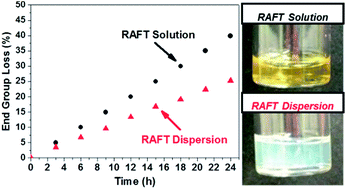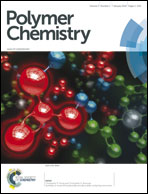Comparison of pseudo-living character of RAFT polymerizations conducted under homogeneous and heterogeneous conditions†
Abstract
RAFT dispersion polymerization of 2,2,2-trifluoroethyl methacrylate (TFEMA) is conducted in ethanol at 70 °C using either poly(2-(dimethylamino)ethyl methacrylate) or poly(methacrylic acid) as a macromolecular chain transfer agent. If the diblock copolymer nanoparticles are not too large, the small refractive index difference between the PTFEMA cores and ethanol leads to minimal light scattering. This enables the pseudo-living character of RAFT formulations conducted under solution and dispersion polymerization conditions to be compared by monitoring the loss of RAFT chain-ends via UV-visible absorption spectroscopy. Significantly fewer chain-ends are lost during RAFT dispersion polymerization, suggesting that such heterogeneous formulations have greater pseudo-living character. Moreover, 19F NMR spectroscopy provides the first direct experimental evidence that RAFT dispersion polymerization proceeds via monomer-swollen block copolymer micelles. The relatively low refractive index of PTFEMA complicates GPC analysis, leading to apparent contamination of the diblock copolymer and erroneously high polydispersities. However, this artefact can be corrected by deconvolution of the GPC curves, followed by their reconstruction using appropriate refractive indices.


 Please wait while we load your content...
Please wait while we load your content...